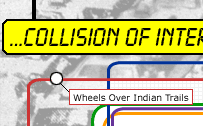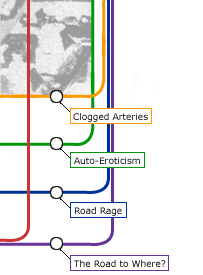



Situationist Theses on Traffic || The Social Ideology of the Motorcar || How Traffic Destroys the Eco-City || Excess
Killed by Automobile
Death in the Streets in New York City 1994-1997
by Charles Komanoff and Members of Right Of Way
Who is dying? Who, and what, is causing the killing? These questions should have been asked, and answered, long ago by the government bodies charged with transport policy, driver licensing and public safety. Instead, how the streets are used, and who dies using them, is never discussed. Policy, if it can be called that, has become merely a question of how best to squeeze the most cars into New York, and move them at the highest speed.
Even here in New York, the nation's only city where drivers are a minority, this "windshield perspective" governs, deflected neither by moral consideration of its costs, nor by factual analysis of local conditions and needs.
Our starting point is an analysis of one thousand deaths of pedestrians and cyclists in New York City in the most recent four years for which data are available. From this analysis emerges a portrait of the ways in which pedestrians and cyclists are endangered -- and killed -- on the city's streets. What emerges as well is an indictment of the police, transport, driver-licensing and criminal-justice authorities for failing in their duty to make the streets safely available to all.
The Current Situation
As this report goes to press, city agencies are claiming that pedestrian deaths fell sharply in 1998, and the Mayor has proclaimed a Draconian "crackdown" on drunken driving which, it is generally assumed, will reduce the number of fatalities even further. Unfortunately, a myopic focus on drunken driving leaves unaddressed the larger problem of aggressive, violent or otherwise irresponsible driving in general, which accounts for the vast majority of pedestrian and cyclist deaths in New York City.
Dangerous drivers can still kill with impunity, so long as they are sober; witness the refusal of the Queens District Attorney to seek criminal charges against an unlicensed driver who killed a 9-year old boy last December on a residential street while fleeing two prior crashes.
Nor is there any indication that government will take steps to reduce the speed, size, engine power, and sheer numbers of vehicles on our streets, and to uphold the rights of citizens to walk and bike safely. Accordingly, we do not expect the putative decline in fatalities in 1998, welcome as it would be, to be sustained, let alone extended.
Key Findings
This report establishes that:
*Most pedestrian deaths are caused by dangerous driving.
*Older New Yorkers stand a far higher chance of dying beneath the wheels of an automobile than of being murdered.
*Federal and city agencies are lavishing resources on coercing motorists to protect themselves with seat belts, and on glamorous but marginal projects like improving helicopter safety, while ignoring the killing of defenseless pedestrians.
*Public officials and the media divert attention from dangerous driving by attacking trivial nuisances like bikes on sidewalks. *Motor vehicles threaten people in every neighborhood, regardless of race and class.
Victims: Summary
People in automobiles killed one thousand and twenty (1,020) people who were not in automobiles (pedestrians, cyclists and others) in New York City during 1994-1997, Rudolph Giuliani's first term as mayor. (We use the term automobile generically to refer to any motor vehicle.) These comprised 56 percent of all traffic fatalities in the city in that period. This report documents 947 of these deaths, based on police accident reports that we obtained and analyzed.
We found that:
*The vast majority, 880, of the 947 victims were pedestrians (including perhaps some in-line skaters or skateboarders who are grouped with pedestrians). The remaining 67, or 7 percent of the total, were riding bicycles.
*A sizable majority of victims, 592, or 63 percent, were male; 351, or 37 percent, were female. (Gender was not reported for 4 cases.) Fatalities among New Yorkers age 65 and above were divided equally between men and women.
*Older New Yorkers--age 65 and above--were more than twice as likely to be killed by automobiles as to be murdered during 1994-97. These older New Yorkers accounted for 35 percent of victims, and were 3.6 times more likely to be killed by automobile than were those under 65. New Yorkers 65 and older were also more than 7 times more likely to be victim than driver in a pedestrian or cyclist fatality.
*Seventy-eight New Yorkers age 85 and older were killed by automobiles during 1994-97. People in this oldest group were 6 times more likely to be killed by automobiles than were NYC dwellers under 65, and were more than four times more likely to be killed by automobiles than murdered.
*Death by car respects no ethnic or class boundaries. Rich and poor neighborhoods, and black, white, Latino and Asian neighborhoods, experienced pedestrian fatalities in proportion to their populations.
*Combined pedestrian and cyclist fatalities averaged 255 per year and were remarkably constant over the four years, with a standard deviation of only 12. The average exceeds by 25 percent the annual average of approximately 200 motor vehicle users who died in crashes in New York City during the same period.
*Brooklyn had the most fatalities, 320, and Staten Island the fewest, 26. Relative to population, Manhattan had the highest borough fatality rate, although this partially reflects victims from other boroughs and from outside the city. Staten Island "s fatality rate relative to population was the lowest, and those for Brooklyn, Queens and the Bronx were roughly similar.
*Ten police precincts (out of the 102 covering the city) reported 20 or more pedestrian or bicyclist fatalities during the four years, topped by the 109th Precinct in Flushing. Since resident and visitor populations vary widely among precincts, these comparisons are incomplete. Nevertheless, it is noteworthy that in three precincts with the most fatalities--Manhattan's Upper East Side and Midtown, and Brooklyn "s Borough Park--public officials and residents have persistently targeted bicycles, rather than automobiles, as a source of danger to pedestrians (see sidebar, p. 55).
*Only five New York City Council districts (out of 51) registered fewer than 10 fatalities during 1994-97. Districts with the most fatalities by borough were: Manhattan, 3rd (West Village and Midtown, Christine Quinn); Brooklyn, 44th (Borough Park, Noach Dear) and 47th (Coney Island, Howard Lasher); Queens, 31st (Rockaway and southeast Queens, Juanita Watkins); Bronx, 13th (southeast Bronx, Madeline Provenzano); Staten Island, 50th (central Staten Island, James Oddo).
Drivers and Vehicles: Summary
*Younger drivers -- ages 19-34 -- caused 485, or almost half (48 percent) of the 1,020 pedestrian and cyclist deaths in NYC during 1994-97, although they accounted for only one-quarter (25 percent) of the city "s population. Adjusted for population, people age 19-34 were 4 times more likely to kill with an automobile thanwere NYC dwellers 60 or over; they were 2.4 times more likely to be the driver than the pedestrian or cyclist victim.
*The youngest drivers--ages 19-26--were the most damaging, killing 255 pedestrians and cyclists during 1994-97. People age 19-26 are only 11% of the population, but they caused 25% of pedestrian and bicyclist deaths. New Yorkers in this age group were 2.7 times more likely to kill a pedestrian or cyclist with an automobile than were all other city residents, and were over 3 times more likely to be driver than victim in a pedestrian or cyclist fatality.
*More than two-thirds (68 percent) of vehicles identified in killing pedestrians and cyclists during 1994-97 were cars, 26 percent were trucks, 5 percent were buses; and 1 percent were motorcycles. Later we compare these percentages with percentages of vehicle types on New York streets, in order to assess the relative danger that they pose. (Unfortunately, government crash statistics do not distinguish between fatalities by sedans and sport-utility vehicles; both are classified merely as "cars. ")
*Small or mid-size trucks accounted for a majority, 167, of the 266 fatalities caused by trucks. Tractor-trailers killed 56 persons, and garbage trucks killed 26. The latter figure, averaging 6-7 per year by garbage trucks, corresponds to 24 fatalities per hundred million miles driven on city streets, an astonishingly high rate.
*Buses killed 53 pedestrians and cyclists in New York City during 1994-97, an average of 13 per year, and an average of 9 pedestrians and cyclists killed per hundred million miles driven on city streets. This was more than 5 times the average motor vehicle rate, and triple the rate for heavy trucks.
Back to top